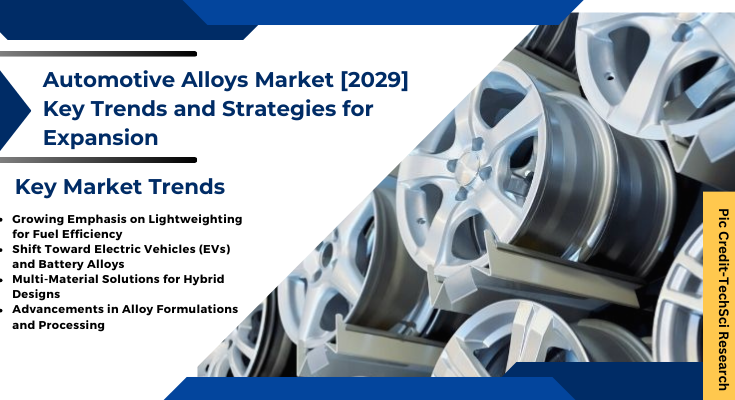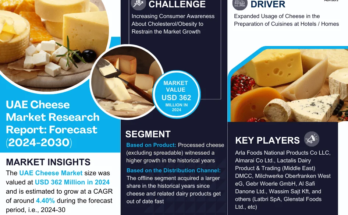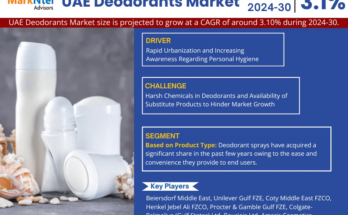According to TechSci Research report, “Global Automotive Alloys Market – Industry Size, Share, Trends, Competition Forecast & Opportunities, 2029”, the Global Automotive Alloys Market stood at USD 102.4 Billion in 2023 and is anticipated to grow with a CAGR of 7.11% in the forecast period, 2025-2029. The Global Automotive Alloys Market is experiencing a remarkable growth trajectory, fueled by the rising demand for lightweight materials in the automobile industry. Automotive alloys, which are predominantly utilized in car manufacturing, play a pivotal role in reducing vehicle weight and enhancing fuel efficiency. These materials are increasingly gaining popularity owing to their exceptional attributes such as durability, corrosion resistance, and impressive strength-to-weight ratios. As automotive manufacturers strive to improve the performance and sustainability of their vehicles, the demand for automotive alloys continues to surge. This trend is expected to drive the growth of the global automotive alloy market in the foreseeable future.
Aluminium and steel alloys play a pivotal role in various industries, with aluminum alloys experiencing a significant surge in demand. This can be attributed to their exceptional lightweight properties and remarkable strength, making them ideal for a wide range of applications. Notably, the global rise in electric vehicle production has further fueled the growth of the market. As electric vehicles require lightweight materials to maximize their range, the demand for automotive alloys has witnessed a substantial increase. This trend is expected to continue as the automotive industry strives for improved sustainability and energy efficiency.
The Asia-Pacific region continues to dominate the global market for automobiles, mainly due to the high concentration of automobile manufacturers in countries such as China, Japan, and India. China, being the world’s largest car manufacturer and consumer, holds significant influence over the market dynamics in the region. Additionally, the European market is also witnessing growth, primarily driven by the implementation of strict emission norms and the rising demand for premium vehicles, reflecting the region’s commitment to sustainability and luxury. This combination of factors has contributed to the sustained expansion of the automotive industry in both the Asia-Pacific and European regions.
While the market outlook appears promising, challenges such as the volatile prices of raw materials and the high cost of aluminium alloys may hinder growth. However, technological advancements and the development of new lightweight, high-strength alloys are expected to offer lucrative opportunities for market expansion.
Competitive landscape analysis reveals a highly competitive market with major players such as ArcelorMittal, Nippon Steel, and Novelis Inc. These companies are focusing on R&D activities, mergers, acquisitions, and partnerships to gain a competitive edge.
Factors such as increasing environmental concerns, strict emission norms, and a global shift towards electric vehicles are expected to drive the growth of the global automotive alloys market in the future. As governments and consumers become more conscious of the environmental impact of conventional vehicles, the demand for lightweight and fuel-efficient alloys is likely to rise. This presents an opportunity for the industry to develop innovative alloys that meet both performance and sustainability requirements. Additionally, the market dynamics and consumer preferences are constantly evolving, necessitating continuous innovation and adaptation by industry players to ensure sustainable growth in this competitive landscape. By staying ahead of the curve and catering to the changing demands of the market, the automotive alloys industry can position itself for long-term success.
Browse over market data Figures spread through 180 Pages and an in-depth TOC on the “Global Automotive Alloys Market” @ https://www.techsciresearch.com/report/automotive-alloys-market/21854.html
The Global Automotive Alloys Market is a dynamic and evolving sector that plays a crucial role in shaping the modern automotive industry. Alloys, which are combinations of two or more metallic elements, offer unique properties that make them indispensable in the manufacturing of various automotive components. These materials contribute significantly to achieving the industry’s goals of enhancing performance, reducing vehicle weight, and meeting stringent environmental standards.
A prominent trend driving the Global Automotive Alloys Market is the growing emphasis on lightweighting for improved fuel efficiency. Automakers are increasingly incorporating lightweight materials to achieve weight reduction without compromising the structural integrity of vehicles. This trend aligns with regulatory standards focused on reducing carbon emissions and addressing consumer expectations for more sustainable and cost-effective transportation solutions. High-strength steel, aluminum, and magnesium alloys are among the materials gaining popularity for their ability to provide strength while reducing overall vehicle weight.
As the automotive industry undergoes a transformative shift toward electric mobility, alloys are playing a pivotal role in supporting this transition. The rise of electric vehicles (EVs) introduces new challenges and opportunities for alloy manufacturers, particularly in the context of battery technologies. Lightweight and durable alloys are essential for components such as battery enclosures, heat sinks, and structural elements within electric vehicles. The demand for alloys tailored for electric vehicle applications is expected to rise in tandem with the increasing adoption of electric powertrains across the automotive landscape.
A noteworthy trend in the Global Automotive Alloys Market is the adoption of multi-material solutions, especially in the context of hybrid vehicle designs. Hybrid vehicles, which combine traditional internal combustion engines with electric propulsion, require a careful balance of materials to optimize performance, efficiency, and structural integrity. This trend involves the strategic integration of various alloys, composites, and materials to achieve specific design objectives, allowing automakers to customize components based on their unique properties.
Continuous advancements in alloy formulations and processing technologies represent another significant trend in the Global Automotive Alloys Market. Researchers and alloy manufacturers are investing in materials science and engineering to develop alloys with improved properties, including enhanced strength, formability, and corrosion resistance. This trend aligns with the automotive industry’s pursuit of materials that can address increasingly complex challenges related to safety, performance, and sustainability. Innovations in alloy technologies contribute to the overall growth and competitiveness of the Global Automotive Alloys Market.
The Global Automotive Alloys Market is witnessing a shift toward sustainable alloy solutions and circular economy practices. Sustainability has become a key consideration across industries, and the automotive sector is actively embracing environmentally friendly practices. Sustainable alloys are those produced with minimal environmental impact, taking into account factors such as raw material extraction, energy consumption, and emissions during the manufacturing process. Aluminum alloys, known for their recyclability, exemplify this sustainability trend, and efforts are underway to enhance the recyclability of other alloy types, such as high-strength steel alloys.
In terms of material types, aluminum alloys have emerged as a frontrunner in the Global Automotive Alloys Market. The use of aluminum alloys in automotive manufacturing offers a compelling combination of lightweight properties, corrosion resistance, and recyclability. These alloys find applications in various vehicle components, including body panels, chassis structures, and engine parts. The demand for aluminum alloys is expected to increase further as automakers prioritize weight reduction for fuel efficiency and overall vehicle performance.
High-strength steel alloys also play a crucial role in the Global Automotive Alloys Market, particularly for components requiring superior strength and crashworthiness. Advanced high-strength steel (AHSS) alloys, characterized by their exceptional strength-to-weight ratio, are widely utilized in structural elements to enhance vehicle safety without adding unnecessary weight. The versatility of high-strength steel alloys makes them integral to achieving both safety and lightweighting goals in modern vehicle design.
Despite the numerous opportunities and positive trends, the Global Automotive Alloys Market faces certain challenges. Cost considerations remain a significant factor influencing alloy adoption in the automotive industry. The production and implementation of advanced alloys often come with elevated costs due to the complexity of alloy formulations, processing techniques, and the use of premium raw materials. Achieving a balance between the benefits of advanced alloys and their associated production costs is a challenge, particularly for mass-market vehicles where affordability is a critical factor.
Another challenge in the Global Automotive Alloys Market is related to the limited formability and joinability of high-strength alloys. While these alloys offer superior strength, they may exhibit reduced formability, making it challenging to manufacture complex and intricate vehicle parts. Joinability issues can lead to difficulties in the welding process, affecting the efficiency and structural integrity of assembled components. Overcoming these challenges requires ongoing research and development efforts to enhance the formability and joinability of high-strength alloys, ensuring their practical applicability in diverse automotive applications.
Corrosion resistance and durability concerns also pose challenges to the Global Automotive Alloys Market. Corrosion resistance is crucial for the longevity and durability of automotive components, especially those exposed to harsh environmental conditions. While aluminum alloys are known for their lightweight properties, they can be susceptible to corrosion, particularly in regions with high humidity or exposure to road salts. High-strength steel alloys, while providing strength, may face challenges related to corrosion over time. Mitigating these concerns requires continuous efforts in developing protective coatings, surface treatments, and alloy formulations that enhance corrosion resistance.
Recycling and sustainability concerns present a challenge in the Global Automotive Alloys Market, particularly as the industry strives for circular economy practices. While aluminum alloys are highly recyclable, challenges persist in the recycling processes, especially when dealing with complex alloy compositions or multi-material components. Ensuring efficient recycling processes for a diverse range of alloy formulations requires standardized practices, collection infrastructure, and technologies that can handle the complexity of alloy materials used in vehicles.
Technological barriers and adoption rates are additional challenges in the Global Automotive Alloys Market. Ongoing research and development are essential to innovate alloy formulations, manufacturing processes, and surface treatments. However, the conservative approach of the automotive industry in adopting new materials poses a challenge. Automakers may be hesitant to embrace advanced alloys without thorough testing and validation processes to ensure that these materials meet stringent safety and performance standards.
In conclusion, the Global Automotive Alloys Market is characterized by a dynamic interplay of trends, opportunities, and challenges. From the increasing emphasis on lightweight and the shift toward electric vehicles to advancements in alloy formulations, the adoption of multi-material solutions, and a focus on sustainability, these factors collectively shape the trajectory of the market. As the automotive industry continues to evolve, alloys will remain a critical enabler for achieving performance, efficiency, and sustainability objectives in vehicle design and manufacturing. The successful navigation of challenges and alignment with market trends will be instrumental in ensuring the continued growth and competitiveness of the Global Automotive Alloys Market.
Major companies operating in Global Automotive Alloys Market are:
- Constellium
- AMG Advanced Metallurgical Group N.V.
- KOBE STEEL, LTD
- Novelis, Inc.
- UACJ Corporation
- ArcelorMittal S.A.
- Nippon Steel & Sumitomo Metal Corporation
- Norsk Hydro ASA
- Thyssenkrupp AG
- Alcoa Corporation
To Download FREE Sample Pages of this Report📥 @ https://www.techsciresearch.com/sample-report.aspx?cid=21854
Customers can also request for 10% free customization on this report.
“The Global Automotive Alloys Market is at the forefront of automotive innovation, driving advancements in vehicle design and manufacturing. Fueled by the quest for lightweight, alloys like aluminum and high-strength steel are reshaping the industry, enhancing fuel efficiency and sustainability. The market embraces trends such as the rise of electric vehicles, multi-material solutions, and a commitment to sustainability through recyclable alloys. Challenges like cost considerations and durability concerns are met with ongoing research, ensuring that alloys remain integral to achieving safety, performance, and environmental goals. As the automotive landscape evolves, the Global Automotive Alloys Market continues to be a cornerstone of progress, embodying resilience and adaptability.” said Mr. Karan Chechi, Research Director with TechSci Research, a research-based management consulting firm.
“Automotive Alloys Market – Global Industry Size, Share, Trends, Opportunity, and Forecast, Segmented By Type (Iron, Titanium, Steel, Copper, and Other), By Application (Chassis, Powertrain, Interior, Exterior), By Vehicle Type (Passenger Vehicle and Commercial Vehicles), By Region, Competition, 2019-2029”, has evaluated the future growth potential of Global Automotive Alloys Market and provides statistics & information on market size, structure and future market growth. The report intends to provide cutting-edge market intelligence and help decision-makers make sound investment decisions. Besides, the report also identifies and analyzes the emerging trends along with essential drivers, challenges, and opportunities in the Global Automotive Alloys Market.
You may also read:
Automotive Airbag Fabric Market [2029] Analysis, Dynamics, and Key Players
Automotive Aftermarket Fuel Additives Market [2029] Exploring Potential, Growth, Future & Trends
Automotive Brake Components After Market Industry | [Latest] Exploring Market Growth, Potential, Trends
Table of Content-Automotive Alloys Market
- Introduction
1.1. Product Overview
1.2. Key Highlights of the Report
1.3. Market Coverage
1.4. Market Segments Covered
1.5. Research Tenure Considered
- Research Methodology
2.1. Objective of the Study
2.2. Baseline Methodology
2.3. Key Industry Partners
2.4. Major Association and Secondary Sources
2.5. Forecasting Methodology
2.6. Data Triangulation & Validation
2.7. Assumptions and Limitations
- Executive Summary
3.1. Market Overview
3.2. Market Forecast
3.3. Key Regions
3.4. Key Segments
- Impact of COVID-19 on Global Automotive Alloys Market
- Global Automotive Alloys Market Outlook
5.1. Market Size & Forecast
5.1.1. By Value
5.2. Market Share & Forecast
5.2.1. By Type Market Share Analysis (Iron, Titanium, Steel, Copper, and Other)
5.2.2. By Application Market Share Analysis (Chassis, Powertrain, Interior, Exterior)
5.2.3. By Vehicle Type Market Share Analysis (Passenger Vehicle and Commercial Vehicles)
5.2.4. By Regional Market Share Analysis
5.2.4.1. Asia-Pacific Market Share Analysis
5.2.4.2. Europe & CIS Market Share Analysis
5.2.4.3. North America Market Share Analysis
5.2.4.4. South America Market Share Analysis
5.2.4.5. Middle East & Africa Market Share Analysis
5.2.5. By Company Market Share Analysis (Top 5 Companies, Others – By Value, 2023)
5.3. Global Automotive Alloys Market Mapping & Opportunity Assessment
5.3.1. By Type Market Mapping & Opportunity Assessment
5.3.2. By Application Market Mapping & Opportunity Assessment
5.3.3. By Vehicle Type Market Mapping & Opportunity Assessment
5.3.4. By Regional Market Mapping & Opportunity Assessment
- Asia-Pacific Automotive Alloys Market Outlook
6.1. Market Size & Forecast
6.1.1. By Value
6.2. Market Share & Forecast
6.2.1. By Type Market Share Analysis
6.2.2. By Application Market Share Analysis
6.2.3. By Vehicle Type Market Share Analysis
6.2.4. By Country Market Share Analysis
6.2.4.1. China Market Share Analysis
6.2.4.2. India Market Share Analysis
6.2.4.3. Japan Market Share Analysis
6.2.4.4. Indonesia Market Share Analysis
6.2.4.5. Thailand Market Share Analysis
6.2.4.6. South Korea Market Share Analysis
6.2.4.7. Australia Market Share Analysis
6.2.4.8. Rest of Asia-Pacific Market Share Analysis
6.3. Asia-Pacific: Country Analysis
6.3.1. China Automotive Alloys Market Outlook
6.3.1.1. Market Size & Forecast
6.3.1.1.1. By Value
6.3.1.2. Market Share & Forecast
6.3.1.2.1. By Type Market Share Analysis
6.3.1.2.2. By Application Market Share Analysis
6.3.1.2.3. By Vehicle Type Market Share Analysis
6.3.2. India Automotive Alloys Market Outlook
6.3.2.1. Market Size & Forecast
6.3.2.1.1. By Value
6.3.2.2. Market Share & Forecast
6.3.2.2.1. By Type Market Share Analysis
6.3.2.2.2. By Application Market Share Analysis
6.3.2.2.3. By Vehicle Type Market Share Analysis
6.3.3. Japan Automotive Alloys Market Outlook
6.3.3.1. Market Size & Forecast
6.3.3.1.1. By Value
6.3.3.2. Market Share & Forecast
6.3.3.2.1. By Type Market Share Analysis
6.3.3.2.2. By Application Market Share Analysis
6.3.3.2.3. By Vehicle Type Market Share Analysis
6.3.4. Indonesia Automotive Alloys Market Outlook
6.3.4.1. Market Size & Forecast
6.3.4.1.1. By Value
6.3.4.2. Market Share & Forecast
6.3.4.2.1. By Type Market Share Analysis
6.3.4.2.2. By Application Market Share Analysis
6.3.4.2.3. By Vehicle Type Market Share Analysis
6.3.5. Thailand Automotive Alloys Market Outlook
6.3.5.1. Market Size & Forecast
6.3.5.1.1. By Value
6.3.5.2. Market Share & Forecast
6.3.5.2.1. By Type Market Share Analysis
6.3.5.2.2. By Application Market Share Analysis
6.3.5.2.3. By Vehicle Type Market Share Analysis
6.3.6. South Korea Automotive Alloys Market Outlook
6.3.6.1. Market Size & Forecast
6.3.6.1.1. By Value
6.3.6.2. Market Share & Forecast
6.3.6.2.1. By Type Market Share Analysis
6.3.6.2.2. By Application Market Share Analysis
6.3.6.2.3. By Vehicle Type Market Share Analysis
6.3.7. Australia Automotive Alloys Market Outlook
6.3.7.1. Market Size & Forecast
6.3.7.1.1. By Value
6.3.7.2. Market Share & Forecast
6.3.7.2.1. By Type Market Share Analysis
6.3.7.2.2. By Application Market Share Analysis
6.3.7.2.3. By Vehicle Type Market Share Analysis
- Europe & CIS Automotive Alloys Market Outlook
7.1. Market Size & Forecast
7.1.1. By Value
7.2. Market Share & Forecast
7.2.1. By Type Market Share Analysis
7.2.2. By Application Market Share Analysis
7.2.3. By Vehicle Type Market Share Analysis
7.2.4. By Country Market Share Analysis
7.2.4.1. Germany Market Share Analysis
7.2.4.2. Spain Market Share Analysis
7.2.4.3. France Market Share Analysis
7.2.4.4. Russia Market Share Analysis
7.2.4.5. Italy Market Share Analysis
7.2.4.6. United Kingdom Market Share Analysis
7.2.4.7. Belgium Market Share Analysis
7.2.4.8. Rest of Europe & CIS Market Share Analysis
7.3. Europe & CIS: Country Analysis
7.3.1. Germany Automotive Alloys Market Outlook
7.3.1.1. Market Size & Forecast
7.3.1.1.1. By Value
7.3.1.2. Market Share & Forecast
7.3.1.2.1. By Type Market Share Analysis
7.3.1.2.2. By Application Market Share Analysis
7.3.1.2.3. By Vehicle Type Market Share Analysis
7.3.2. Spain Automotive Alloys Market Outlook
7.3.2.1. Market Size & Forecast
7.3.2.1.1. By Value
7.3.2.2. Market Share & Forecast
7.3.2.2.1. By Type Market Share Analysis
7.3.2.2.2. By Application Market Share Analysis
7.3.2.2.3. By Vehicle Type Market Share Analysis
7.3.3. France Automotive Alloys Market Outlook
7.3.3.1. Market Size & Forecast
7.3.3.1.1. By Value
7.3.3.2. Market Share & Forecast
7.3.3.2.1. By Type Market Share Analysis
7.3.3.2.2. By Application Market Share Analysis
7.3.3.2.3. By Vehicle Type Market Share Analysis
7.3.4. Russia Automotive Alloys Market Outlook
7.3.4.1. Market Size & Forecast
7.3.4.1.1. By Value
7.3.4.2. Market Share & Forecast
7.3.4.2.1. By Type Market Share Analysis
7.3.4.2.2. By Application Market Share Analysis
7.3.4.2.3. By Vehicle Type Market Share Analysis
7.3.5. Italy Automotive Alloys Market Outlook
7.3.5.1. Market Size & Forecast
7.3.5.1.1. By Value
7.3.5.2. Market Share & Forecast
7.3.5.2.1. By Type Market Share Analysis
7.3.5.2.2. By Application Market Share Analysis
7.3.5.2.3. By Vehicle Type Market Share Analysis




